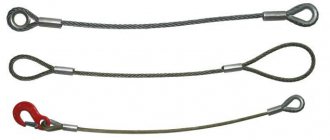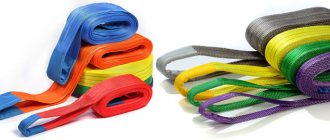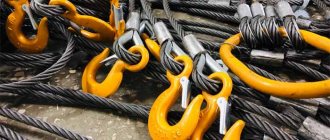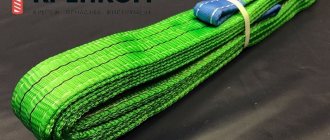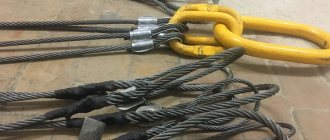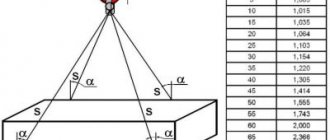Slings are a device for lifting and moving loads.
It may be based on a rope, chain or cable. The device must securely secure the cargo that needs to be transported, while ensuring safety for workers and the safety of the goods. Lifting slings, regardless of the area in which they are used, must be in accordance with state standards. Certification of this type of product is mandatory.
Slings are used in construction, industrial sectors, and agriculture. According to the material, they can be rope, chain and textile.
Rope slings
Rope slings can withstand both very low (-40 degrees) and very high temperatures (400 degrees).
The rope is made from wire woven into strands. This design makes it possible to detect abrasion early and thus prevent sudden rupture of the lifting device.
The price of a sling depends on its type, length and load capacity.
For example, a single-branch rope sling 1 meter long and with a carrying capacity of 32 kilograms costs 111 rubles. A ten-meter sling holding 10 tons costs 5,350 rubles. The more branches, the more expensive the sling.
Models
There are two ways to produce rope slings:
- crimping with an aluminum bushing (filling);
- hand weaving (braiding);
- Single branch sling (1 SC). Consists of one rope branch.
- Two-legged sling (2 SK). Widely used in industrial enterprises and warehouses.
- Four-legged sling (4 SK). The design has a link and 4 rope branches. Often used in construction, warehouses and factories.
- Rope branch (VK). The ends of the branches are sealed either with braiding or crimping.
- Ring sling (SKS). The hook is in contact with the load.
- Loop sling (Loop sling). Like the ring one, it ensures contact of the hook with the load. One of the most common types of rope slings.
Lantsyugov's slings
The head element of the lance sling is a steel lance with a value class of 4 to 12. To connect the lance slings, welding is required. Gilks are equipped with hooks. Dovzhina hilok can reach 20 meters. Lantsyugov slings are considered universal, as they can be used for work with all types of applications. It is required in metallurgy, in chemical, nuclear, burning industries, in important machinery, as well as in warehouse facilities.
Like other types of similar attachments, lancets are classified according to design and divided into heels and rings. Virobniks use the following types of lance slings:
- 1SC – single-headed, can be used both independently and for collecting multiple-headed compounds;
- 2SC – double;
- 3SC – triohgilkovi;
- 4SC – either gilkovic or lantzug “spiders”, suitable for working with items of non-standard shape;
- VTs – Lantsyugova gіlka, equipped with rings or hooks;
- USC – universal rings, vikorista for girth of vantages;
- STs1VZ – with one closed loop;
- STs2VZ - with two closed pins.
The importance of lance slings depends on the value class of all their elements. With a higher class, the quality of the lancet decreases, and the materiality of the application increases the term of its service. Slings of various classes of value may have the following resistance (data given for temperatures up to 200 degrees for one lance with a minimum diameter):
- class 3 – up to 100 kg;
- class 5 – up to 300 kg;
- class 8 – up to 800 kg;
- class 10 – up to 1200 kg;
- class 12 – up to 3150 kg.
At elevated temperatures, the permissible intensity of the germs changes by 10-15%.
The importance must be placed in the middle and according to the diameter of the Lancug strap. This information is presented in the table:
Lantsyugov's slings are thinner, which allows for different slinging methods. Suspension can be cured at temperatures ranging from -40 to +500 degrees. This category of slings can be repaired. Damaged lanks can be replaced and the vibrator removed. Lantsyugov's vantage-proof installations are considered to be the safest, since deformation of the straps can be detected immediately. The dovzhin of Lanzug can be changed in the future, if necessary.
If there are not enough people, then there are not enough of them. Lantsyugov's lines are wobbling a great wave. Ale lancets of high quality classes (8-12) are produced in a smaller diameter, which practically fits a small part. Another minus of pristosuvan is high varity.
Chain slings
A chain sling is a chain of steel links connected to each other by welding.
Very durable design, flexible and comfortable. Withstands loads with sharp edges. Such slings are easy to repair. They are not damaged by acids, open fire, or low temperatures. Compared to rope slings, chain slings weigh more.
The cost of a single-leg chain sling with a lifting capacity of 1 ton is about 1,000 rubles, 8 tons is approximately 5,000 rubles.
Models
- Single-leg sling (1SC). Can be used at extremely low or high temperatures.
- Two-legged sling (2SC). Due to two branches, it has greater lifting capabilities than 1SC. If the load is critical, the chain links will stretch but not break. Used in rigging and construction. The sling is hung on the crane hook. You can adjust the length of the branches.
- Four-leg sling (4 SC). This sling is also called a chain spider. Consists of a link and four branches of chains. Used for lifting and transporting cargo of non-standard shape.
- Chain branch (CCB). It usually serves as a spare part for repairing a chain sling, but can also be used independently to connect cargo and lifting equipment.
- Ring sling (RSS). Otherwise called universal. The chain in this case looks like a ring. Used for lifting and transporting loads in extreme temperature conditions. Suitable for moving loads with sharp contours.
Marking
The tag attached to the sling must contain the following information:
- type of sling (number of branches and their material);
- lifting capacity in tons;
- sling length in millimeters;
- serial number;
- date of testing of the device at the factory;
- name of the manufacturer;
Pros and cons of the solution
Among the advantages of the product are:
- wide temperature range of use, possibility of use in contact with open fire and aggressive chemicals;
- this type of sling is considered the safest, since deformation of the links can be immediately detected;
- working elements have high mobility and flexibility, with them it is possible to implement various slinging schemes;
- the maintainability of all elements ensures a long service life;
- The length of the chains can be reduced if necessary - this function is performed by the limiting hooks provided in the upper segment of the product.
The only obstacle to the ubiquity of the product is its significant cost, but this disadvantage is compensated by its unlimited service life.
Textile slings
They differ from other types of slings in their greater versatility.
Polyester tape is used as the material for textile slings. Such lifting devices do not damage the load when moving it. The color of the sling depends on the load its design can withstand.
The slings are protected by a special fabric, which extends their service life. It is not particularly difficult to carry them under a load and attach them to a crane hook. They do not deteriorate from contact with oil, water, or acids.
They can be used in any climatic conditions. They do not lose their properties even with a sharp temperature change.
A textile sling 30 millimeters wide, 1 meter long and with a carrying capacity of 1 ton costs 140 rubles. A nine-meter one with the same carrying capacity costs 730 rubles.
Models
- Tape slings. They are needed to lift and move various loads that require careful handling - a soft grip. The coating, shape, and structure of the product are not affected.
- Circular slings. They are made from very durable polyester ring fiber. With the help of such slings, large loads (up to one hundred tons), but requiring delicate handling, are lifted and transported.
Marking
- STK - textile ring slings, made of one or several layers.
- STP - textile loop slings, made of one or several layers.
The tag indicates the lifting capacity of the sling (0.5...50 tons), its type, length, type of loop (ring).
There may be such marking: 1ST. This means that there is one branch in the textile sling.
Textile slings
Both lanyards and rope slings add foldables for maneuvering and importance. The stench is not suitable for robots with loud or far-fetched vantages, because they can damage the surface. In this situation, textile slings will come in handy as they provide the necessary flexibility, reliable fixation and necessary slinging.
Textile slings come in two types – stitch or round-strand. The first ones are produced in seemingly stitches from one or several balls of synthetic material (nylon, polyester or propylene). Round strand slings are made from a polyester core placed in a sleeve made of polyester or nylon fabric. For plasticity and flexibility, round-strand models are superior to stitch ones.
The design of the sling is divided into three types:
- loops (STP) – a stitch with two loops at the ends, covered with tread fabric;
- kіltsevі (STK) – a stitch, closed in a ring;
- Gilkov - can be with one (1ST), two (2ST), three (3ST) or several (4ST) sleeves equipped with vantage-spitting elements.
The designation of orbicular virobes is preceded by the letter “K”. Ring and loop options are the most universal. They are used for tying the vantages.
The slings are made in different colors. The color of the stitch means its importance. Color identification is used for clear visual distinction between colors. The width of the stitch also depends on the flexibility of the stitching.
The main advantage of textile slings is their compactness and low weight. When stored properly, they take up minimal space and are easy to transport. The top stitching does not damage the fabric. Synthetic materials, made from chemically resistant materials, are resistant to temperature changes, moisture, infusion of naphtha products and organic solvents. Fabricating textile slings is much cheaper than rope and lance slings.
The maximum temperature of the surface of the rods with which the lines are in contact must not exceed 100 degrees, and the minimum cannot be lower than -40 degrees. Textile materials are not resistant to acids or acids. Preserve drying only in closed areas due to resistance to ultraviolet radiation.
Traverses
Traverses are special removable devices for grasping cargo.
It secures goods during loading and unloading and can be used for lifting long loads or where height is limited. Crossbars are manufactured according to drawings, depending on the task they will have to perform. They make mounting traverses, magnetic and lifting.
Lifting beams lift the crane beams and the braking system. The gripper is secured with a pin to the beam under the crane. When the crane beam is installed in the design position, the pin is removed. The crossbars are attached with hooks to a special platform.
Magnetic traverses do not require external energy to hold the load. The magnetic field created by the devices does not interfere with the operation of neighboring mechanisms. The length of the traverse is changed using 2 cylinders. A load length of 12 meters is possible.
Grips
To simplify the work of slinging loads, the slings are equipped with links that act as grippers.
Grips can be different in operating principle, design and size. They are often used to organize the production of mass goods - where it is necessary to transport a lot of similar cargo.
The grips are made of alloy and low-alloy steel, and due to this, the devices are small and light.
Types of grips
- Kleshchevoy. Resembles scissors, the ends of which grip a load or part of a load.
- Eccentric. The load is held by eccentrics. Typically used for transporting flat loads.
- Clamping. Clamps the load, holding it.
- Fork. The gripper is under load.
- Koromyslovy. The working body of such a grip is similar to a rocker arm. It is used to work with loads that have holes.
- Klinova. The working element of the gripper jams in the hole of the transported load.
- Shtyrevoy. The pin is secured in the hole of the load being moved.
- Magnetic. With the help of such grips, ferromagnetic loads are lifted, moved and held. The load is held by high-power magnets. They can be used for 15 years. This type of grip is convenient to use, since there is no need to use slings. The magnet touches the load with its working surface, a special lever turns on the magnetic field. If you return the lever to its original position, the field is turned off.

